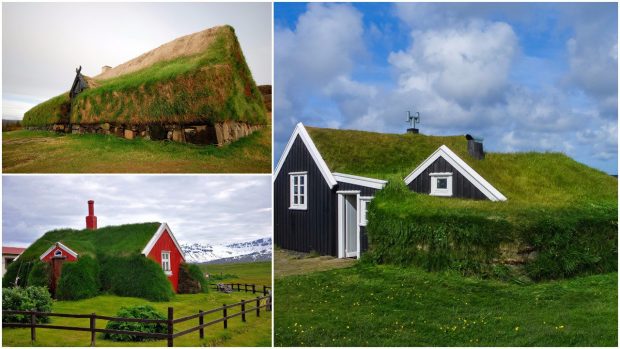Beautiful surviving examples of the traditional Icelandic turf house

There are about a gazillion reasons why Iceland should be on everyone’s bucket list. The fairytale-like turf houses are a reason more. One of the girls here at Outdoor Revival HQ seems to think that it’s worth visiting just in case there are some fairies involved. The rest of us just want the opportunity to visit the land of Vikings.
The picturesque turf houses in Iceland known as torfbæir are major attraction among the visitors to the island. Turf houses are not unique to Iceland, they have been constructed throughout many centuries in Europe, Greenland, North America and the Faroe Islands. Although the methods of turf building in Iceland are fairly unique to the island.

A house with a turf roof and walls near Reykjavik, Iceland. Turf was plentiful in Iceland and provided superior insulation against the weather compared to wood or stone.
Turf was also easy to process (dig up) and to work with. The ability to cut and shape it with minimal tools makes it a very friendly material to work with and then as it matures it binds itself together making it very strong and very resistant to the sometimes awful weather conditions.

Another house near Reykjavik, Iceland (above). This house blends in particularly well with the surrounding countryside, it’s as though it’s grown up from the ground rather than being built and then turfed.

Front side of old farmhouse at Tyrfingsstadir Skagafjordur northern Iceland.

The harsh climate and conditions in Iceland made it practically impossible to build a structure solely made of stone or wood; turf offered far superior insulation and an ease of construction.


When first settled, 30% of Iceland was forested, mostly with birch. Even though the preferred timber for building Norse halls in Scandinavia was oak, the native birch had to serve as a main framing material on the secluded island. However, there was an abundance of turf that was suitable for construction.

The traditional Iceland turf house would have a large foundation made of flat stones, and a wooden frame which would hold the turf.


The turf was then fitted around the wooden frame in blocks with a second layer or in the more modern herringbone style. The only external wood was the doorway.


A fascinating aspect of the Icelandic turf house was the advent of attached toilets, which were communal, and the act of going to the bathroom was commonly done in large groups.



Icelandic architecture evolved in many ways in the more than 1,000 years the turf houses were being constructed. In the 14th Century, the Viking longhouses were deliberately abandoned and small, specialized, interconnected buildings were built instead.




In the late 18th century a style known as the burstabær started to gain momentum and is the most popular version of the Iceland turf houses.
If you have any comments then please drop us a message on our Outdoor Revival Facebook page
If you have a good story to tell or blog let us know about it on our FB page, we’re also happy for article or review submissions, we’d love to hear from you.
We live in a beautiful world, get out there and enjoy it.
Outdoor Revival – Reconnecting us all with the Outdoor
